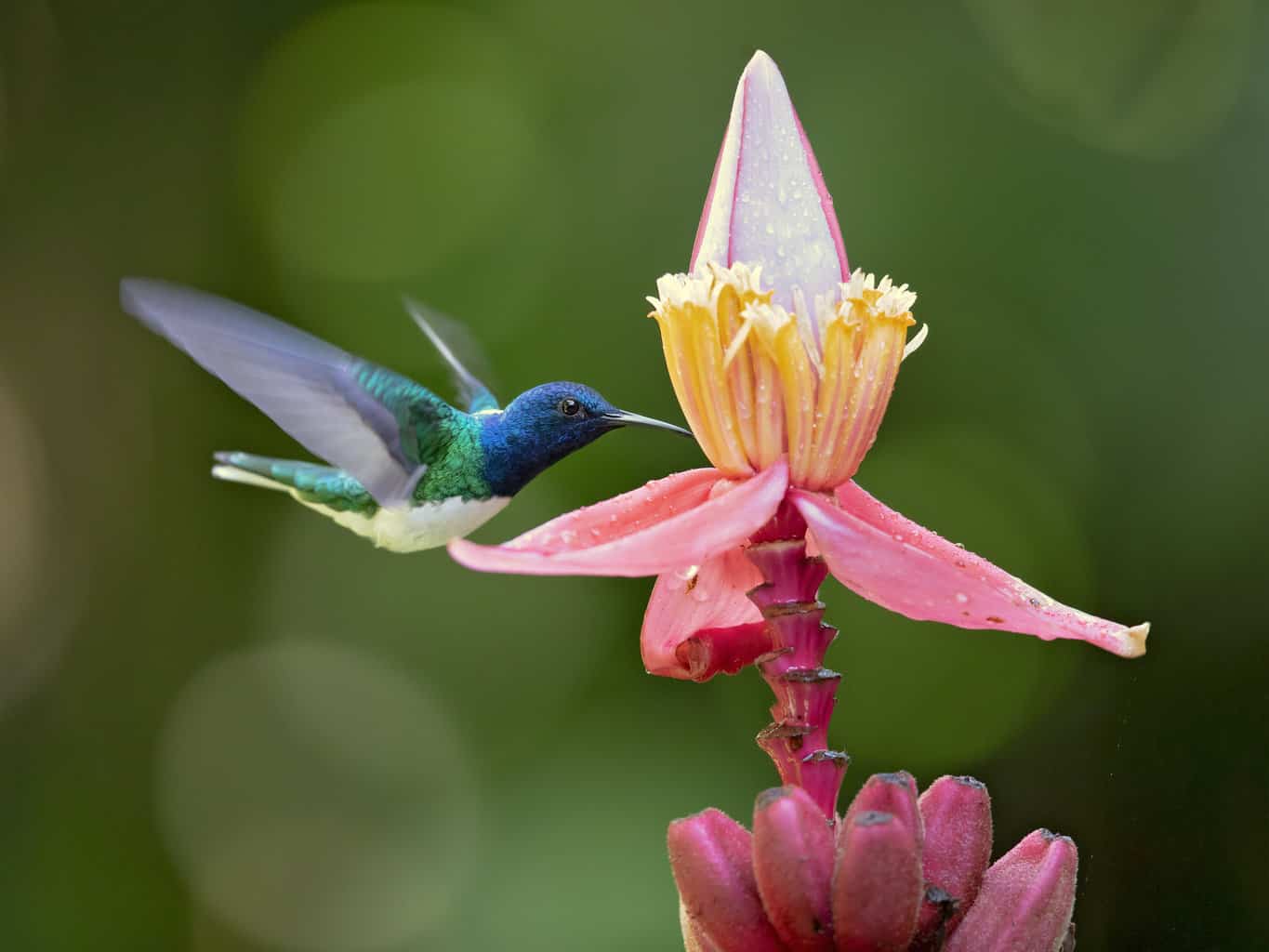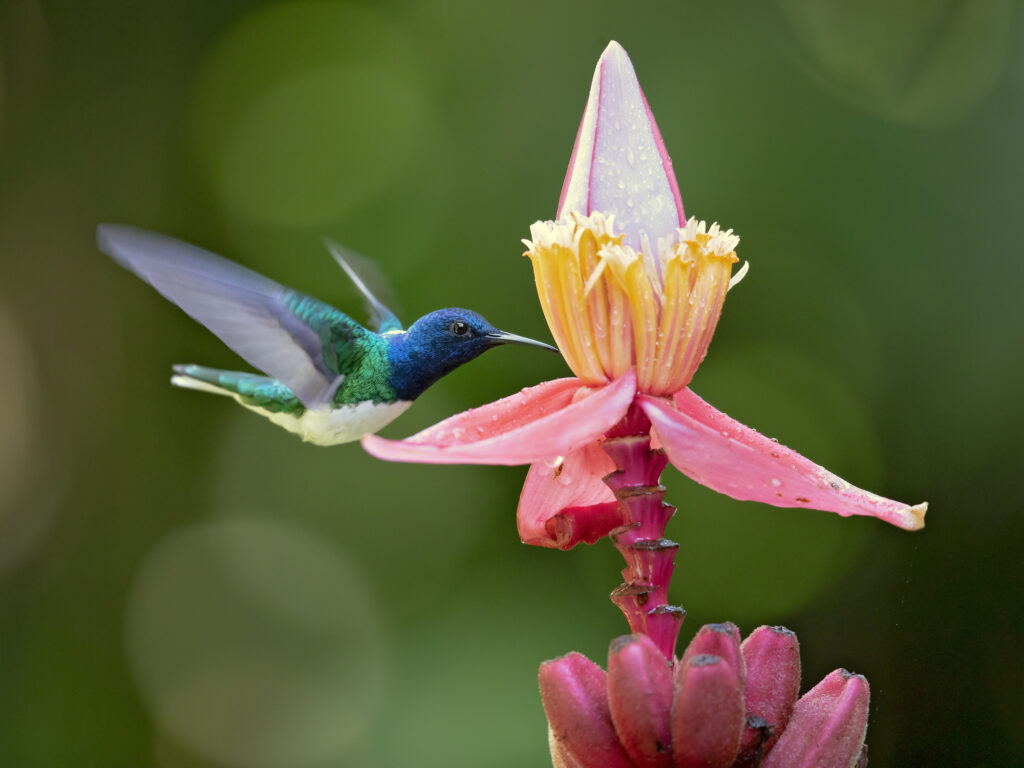Attracting hummingbirds to your yard can seem daunting and can be a little bit frustrating at times. However, with a couple of easy steps, you can increase your chances of enjoying these busy little birds throughout the summer months.
Plant Native Flowers to Feed Hummingbirds
While the quickest and easiest thing you can do to benefit hungry hummingbirds is to put up a feeder, planting native flowering plants popular with hummingbirds is the best thing you can do to attract them to your yard for good.
Planting a yard full of flowers provides food sources for hummingbirds both in the form of nectar also insects. Hummers are known for drinking nectar, but they also feed regularly on certain types of insects like ants and gnats.
You may not like the thought of more bugs in your yard, but insects are part of the natural world, and if you want to see birds, you’ll need to get used to insects.
As far as nectar-rich flowers, hummingbirds are partial to tubular flowers and are drawn to the bright colors of red, orange, and yellow.
Among the types of flowers that work well to attract common hummingbirds in different parts of the country are honeysuckle, columbine, hummingbird trumpet, and salvia. For a full list of hanging and planted flowers for hummingbirds, click here.
Not all flowers are popular with hummingbirds, including some that are popular with insect pollinators like bees and butterflies. Do some research in the spring before you begin your landscaping for the year in order to make sure you’re planting the right ones.
Put up a Hummingbird Feeder

The quickest thing you can do to attract hummingbirds is to buy and put up a hummingbird feeder in your yard. Hummingbird feeders can be purchased rather inexpensively, and creating your own hummingbird food is quick and simple.
Here are a few affordable hummingbird feeder suggestions:
Juegoal Window Hummingbird Feeder
- 8 ounce capacity with 3 feeding ports, convenient hummingbirds to eat nectar.
- Brings beautiful hummingbirds right to the window for unobstructed view of birds.
- Can use this feeder with or without the ant moat to keep away the crawling insects.
Last update on 2024-04-24 / Affiliate links / Images from Amazon Product Advertising API
Some people worry that window feeders may increase collisions with their windows, but research actually shows that feeders placed within three feet of windows reduce collisions.
Window bird feeders get you as close as possible to the birds in your yard and keep the birds safer. Seems like a win-win!
Aspects 407 Window Hummingbird Feeder
- The bright red cover attracts the birds.
- HighView perch invites birds to rest comfortably as they drink from any of three feeding ports.
- Features a generous 8 oz. capacity, sturdy polycarbonate construction, and a suction-cup mounted bracket.
Last update on 2024-04-24 / Affiliate links / Images from Amazon Product Advertising API
Another window feeder to consider for your yard. Like the previous example, it holds eight ounces of nectar with a round, aesthetically pleasing shape.
Both this one and the one before it have an ant moat that can be filled with water to reduce the number of insects in your nectar.
Perky Pet Glass Hummingbird Feeder
- Accommodate Multiple Birds – This feeder boasts four flower-shaped feeding ports with comfortable perches so multiple birds can...
- Built-in ant moat can be filled with water to create a barrier against ants
- Wide-Mouth Bottle – No more messes and no more spills, the wide-mouth bottle makes filling easier, resulting in fewer spills as...
Last update on 2024-04-24 / Affiliate links / Images from Amazon Product Advertising API
The classic feeder shape that many people are accustomed to, hummingbirds have been coming to feeders like this one for a long time.
This feeder has six ports, although with how territorial hummingbirds can be, you’ll be lucky to fill up all those ports at once!
For more normal bird feeder recommendations, including a full breakdown of different styles and their benefits, click here.
Hummingbird Feeder Tips
Keep it simple and fresh
Once you’ve got your hummingbird feeder, fill it with a nectar mixture that’s four parts water to one part table sugar. Don’t use artificial sweeteners or honey – keep things simple when feeding hummingbirds.
Artificial sweeteners won’t give hummingbirds the energy that they need and honey can be toxic for birds.
You can also skip the red food coloring. Most hummingbird feeders are already red, so food coloring is unnecessary.
It’s also important to keep your hummingbird food fresh throughout the summer months, replacing it regularly, even before it starts to fill with insects, get cloudy, or become moldy.
The warmer the days, the more you’ll want to change out your nectar, as it can go bad quickly on hot days. You can also keep your hummingbird food good longer by keeping it out of direct sunlight.
Location, location, location
When you’re setting up a hummingbird feeder, place it in an area where hummingbirds are likely to frequent. For instance, areas where they make nests in trees or that grow flowers they regularly feed on.
If you don’t already see hummingbirds but are looking to attract them with a feeder, put your feeder in a location where hummingbirds feel safe, such as near trees or bushes where they can scope out the situation and retreat to safety easily if they sense danger.
While they eat a lot, they also spend a lot of time perched, looking for potential predators and sources of food.
Timing is everything

Timing is very important when trying to attract hummingbirds. Make sure to have your hummingbird feeders placed (and hummingbird flowers planted, if possible) early enough to catch them as they make their annual spring migration.
If you’re too late and the hummingbirds have already passed through, your chances of one taking up residence near you will be lower.
It may not be possible to have spring flowers planted in every location by the time hummingbirds go through, but having your feeders out and a water source nearby when they’re migrating can make a huge difference.
Add water to your bird offerings
One often-missed aspect when crafting a yard that caters to birds, including hummingbirds, is adding water sources.
Some people say that the sound of running or dripping water will attract hummingbirds, but it doesn’t necessarily have to be moving water. A regular bird bath will also help create a welcoming environment for hummingbirds and other birds.
For a list of bird bath options, click here.
Frequently Asked Questions
How long does it take hummingbirds to find a feeder?
There’s no sure answer to this question. Sometimes, if there aren’t hummingbirds in your area, it may go un-visited, at least for that breeding season. Other times, you may put out a feeder and find instant success.
Make sure to have your feeders put out before you normally expect hummingbirds to come through on their annual migration. Then, when they’re coming back north for the season, they’ll be more likely to stop and potentially even hang around for a while.
If you’re in an area where hummingbirds are present year-round, attracting them to your property can still take time, so be patient.
Plant native plants for hummingbirds to find food and shelter, put out feeders and water, and keep them fresh and ready for when a hummingbird does decide to stop by.
What are hummingbirds most attracted to?
Hummingbirds are attracted to an area that provides them with everything they need to survive, notably food and shelter.
With this in mind, a yard full of life is a great first step. Native flowering plants with tubular shapes, trees or bushes for cover and nesting, and insects for food are all important for a hummingbird’s survival.
Keep this in mind when you’re doing your backyard landscaping, and focus on native plants that encourage a lively backyard ecosystem.
Why aren’t hummingbirds coming to my feeder?
If you’ve had your hummingbird feeder out for a while with no luck, there could be a number of factors at play.
First of all, double-check that your hummingbird nectar is fresh. A moldy, cloudy, or insect-filled hummingbird feeder is a quick turnoff for any hummingbird. It’s unhealthy and not tasty for them, and they’ll instantly look for other food sources.
If you’re regularly cleaning your feeder and switching out the nectar to keep it fresh, it’s possible that you may not have hummingbirds in your area or they haven’t found the feeder.
You may also want to consider the location of your feeder. Hummingbirds can be easily scared off by larger birds, cats, or even bees and wasps. If they sense danger or the feeder isn’t in a location where the birds feel safe, they may be less likely to visit.
How do you attract hummingbirds quickly?
There’s no instant answer for how to attract hummingbirds quickly. It’s not something that just happens overnight unless you are already seeing hummingbirds in your area.
Since it can take some time to cultivate a backyard full of native plants and insects, the quickest thing you can do is fill a feeder with fresh nectar from flowers. If there are hummingbirds in your area, you may be able to lure one in with a feeder.

